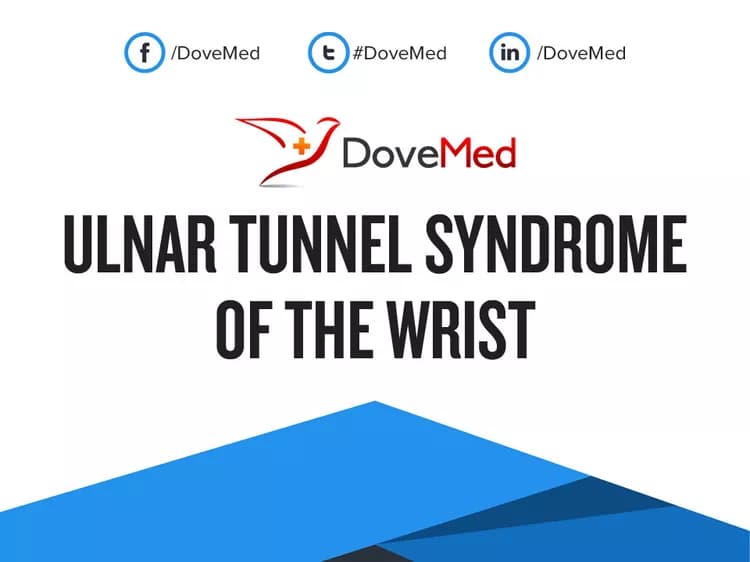What are the other Names for this Condition? (Also known as/Synonyms)
- Guyon’s Canal Syndrome
- Handlebar Palsy
- Ulnar Nerve Entrapment at the Wrist
What is Ulnar Tunnel Syndrome of the Wrist? (Definition/Background Information)
- The ulnar nerve is the longest unprotected nerve in the human body (meaning it is not protected by any bones or muscles). It is also one of the 3 key nerves that provide sensation and function to the hand
- The ulnar nerve begins at the neck and travels all the way down the inside of the forearm to the palm of the hand. At this point, the ulnar nerve branches out within the palm and into the ring and little fingers
- Ulnar Tunnel Syndrome of the Wrist is a condition characterized by an entrapment of the ulnar nerve as it passes through the Guyon’s canal within the wrist. Women are more likely to develop this condition, than men
- The most common cause of Ulnar Tunnel Syndrome is a ganglion cyst, which is a noncancerous fluid-filled lump that usually originates from the wrist joint
- The treatment for Ulnar Tunnel Syndrome of the Wrist includes both nonsurgical and surgical methods. The prognosis of this wrist condition is usually excellent with proper treatment
Who gets Ulnar Tunnel Syndrome of the Wrist? (Age and Sex Distribution)
- Ulnar Tunnel Syndrome of the Wrist may occur in individuals of all ages, races, ethnic groups, and gender
- Overall, women are more likely to develop this condition, than men
What are the Risk Factors for Ulnar Tunnel Syndrome of the Wrist? (Predisposing Factors)
Common risk factors associated with Ulnar Tunnel Syndrome of the Wrist include:
- Individuals, who participate in sports that involve repetitive stress on the wrist, such as gymnastics, tennis
- Certain occupations that require repetitive overuse of the wrist, such as carpentry or painting
- Females have a higher risk for Ulnar Tunnel Syndrome of the Wrist, than males
It is important to note that having a risk factor does not mean that one will get the condition. A risk factor increases ones chances of getting a condition compared to an individual without the risk factors. Some risk factors are more important than others.
Also, not having a risk factor does not mean that an individual will not get the condition. It is always important to discuss the effect of risk factors with your healthcare provider.
What are the Causes of Ulnar Tunnel Syndrome of the Wrist? (Etiology)
Causal factors associated with Ulnar Tunnel Syndrome of the Wrist include:
- Any repetitive stress on the wrist joint, such as associated with sports
- A ganglion cyst that originates at the wrist joint
- Persistent pressure or repetitive trauma on the wrist that is related to certain occupations, such as carpentry, painting, or other construction-related works
What are the Signs and Symptoms of Ulnar Tunnel Syndrome of the Wrist?
Sign and symptoms of Ulnar Tunnel Syndrome of the Wrist include:
- Tingling sensation within the little finger (pinky) and ring finger
- Pain within the wrist
- Difficulty gripping objects
- Loss of ulnar nerve function
How is Ulnar Tunnel Syndrome of the Wrist Diagnosed?
Ulnar Tunnel Syndrome of the Wrist is diagnosed using the following tools:
- Physical examination:
- A thorough physical examination is important in determining, if an individual has Ulnar Tunnel Syndrome of the Wrist
- During this exam, a physician will examine the hand, to look for any common signs of the syndrome, such as a diminishing or loss of muscle tissue, muscle weakness, or dry skin within the spaces between the fingers
- A physician may also lightly tap his/her finger over the ulnar nerve to determine, if it causes any irritation
- Individuals are also expected to provide an explanation of the circumstances that led up to the injury
- In addition to this, a complete medical history will aid in arriving at a definitive diagnosis
- X-rays of the wrist: X-rays use radiation to produce images of the wrist. It can help the physician rule out other possible causes for wrist discomfort, such as if a fragment of a fractured bone is pressing on a nerve
- Computerized tomography (CT) scan of wrist joint: A CT scan takes a series of x-ray images from several different angles. These images are then combined to create cross-sectional images of bones and soft tissues with the body. This allows the physician to examine the wrist joint and surrounding structures of the hand
- Magnetic resonance imaging (MRI) of the ulnar nerve: An MRI is a more detailed scan that uses strong magnetic fields to produce clearer images of the bones and soft tissue that surrounds the wrist. This allows a physician to view any damage to the wrist
- Electromyography (EMG) of affected region: An EMG shows the electrical activity of the muscle during rest and contraction of the muscle. Examining the electrical activity may help a physician study any injury to the ulnar nerve within the wrist
- Nerve conduction velocity (NCV) of ulnar nerve: Nerve conduction velocity shows the speed at which electrical signals move through a nerve. Slowing of nerve conduction speed may indicate damage to the ulnar nerve
Many clinical conditions may have similar signs and symptoms. Your healthcare provider may perform additional tests to rule out other clinical conditions to arrive at a definitive diagnosis.
What are the possible Complications of Ulnar Tunnel Syndrome of the Wrist?
Complications of Ulnar Tunnel Syndrome of the Wrist include:
- Permanent injury to the ulnar nerve
- Permanent weakness and numbness within the wrist and hand
- Chronic pain
- Emotional depression, due to an inability to participate in athletic, professional, or recreational activities
How is Ulnar Tunnel Syndrome of the Wrist Treated?
The treatment measures for Ulnar Tunnel Syndrome of the Wrist include both nonsurgical and surgical methods.
Nonsurgical treatment methods for Ulnar Tunnel Syndrome of the Wrist include:
- Any activity that aggravates the wrist condition should be avoided. The physician may advise the individual to refrain from participating in any physical activities, until the pain stops or symptoms improve
- Applying ice (or a damp heated towel) to the wrist can help reduce pain and swelling
- Complete immobilization of the wrist with a cast may be required to restrict movement
- Non-steroidal anti-inflammatory oral medications, such as indomethacin and naproxen, may be used to treat Ulnar Tunnel Syndrome of the Wrist. These medications can help decrease the pain and swelling
- Corticosteroid injections help in temporary relieving symptoms, such as pain, and in improving the range of motion
- It is important to begin some light exercises after the symptoms have decreased. Physical therapy may help restore strength, as well as flexibility in the muscles
Surgical treatment methods for Ulnar Tunnel Syndrome of the Wrist include:
- Surgical excision: Most cases of Ulnar Tunnel Syndrome are caused by an abnormal growth at the wrist, which necessitates a surgical excision. Surgical excision involves the removal of the ganglion cyst, scar tissue, or it may help mitigate any other factor that causes compression of the ulnar nerve
- Endoscopic ulnar tunnel release: Endoscopic ulnar tunnel release is a minimally-invasive surgical procedure that allows a physician to examine the carpal tunnel within the wrist using an orthopedic device, called an endoscope. During this procedure, the volar carpal ligament, located on the top of the Guyon’s canal is cut; thereby, decreasing any abnormal pressure on the ulnar nerve. This helps reduce the symptoms associated with Ulnar Tunnel Syndrome of the Wrist
How can Ulnar Tunnel Syndrome of the Wrist be Prevented?
Currently, there are no preventative measures for Ulnar Tunnel Syndrome of the Wrist. However, following certain guidelines may help decrease abnormal pressure on the ulnar nerve. These include:
- Keep an adequate time period to gradually cool down after exercising
- Have or learn the proper technique, while participating in sports or any physical activity, in order to reduce the chance of an injury to the ulnar nerve within the wrist
- Take regular breaks by occasionally bending or stretching the hands or wrists. Individuals, who work in offices are advised to alternate between tasks
- A high percentage of hand and wrist related pain and stiffness develop, when the temperature in the work place is cold. Wearing proper attire to help keep the hands and wrist warm may be helpful
- Many individuals tend to use unwarranted, excessive force to perform simple tasks involving the hands, when the situation may demand a lot lesser force. A relaxed grip can limit the amount of stress applied to the Guyon canal
What is the Prognosis of Ulnar Tunnel Syndrome of the Wrist? (Outcomes/Resolutions)
- Ulnar Tunnel Syndrome of the Wrist may range from being a minor condition, to a serious disability
- Even though over half of all individuals may require surgery, the long-term prognosis is usually good in a majority of the individuals
- If left untreated, severe cases of Ulnar Tunnel Syndrome may result in permanent loss of muscle strength and sensation, which results in a decreased ability to participate in any athletic, professional, or recreational activities
- If detected and treated early, signs and symptoms of the syndrome can be controlled, and in many instances they may altogether disappear
Additional and Relevant Useful Information for Ulnar Tunnel Syndrome of the Wrist:
The following DoveMed website link is a useful resource for additional information:
Related Articles
Test Your Knowledge
Asked by users
Related Centers
Related Specialties
Related Physicians
Related Procedures
Related Resources
Join DoveHubs
and connect with fellow professionals


0 Comments
Please log in to post a comment.